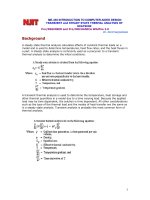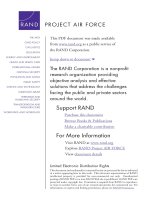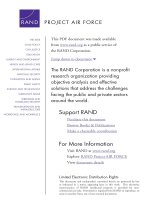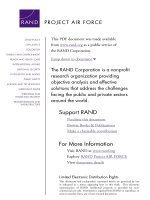Supporting Air and Space Expeditionary Forces - Analysis of Combat Support Basing Options potx
Bạn đang xem bản rút gọn của tài liệu. Xem và tải ngay bản đầy đủ của tài liệu tại đây (1.58 MB, 137 trang )
This PDF document was made available
from www.rand.org as a public service of
the RAND Corporation.
6
Jump down to document
Visit RAND at www.rand.org
Explore RAND Project AIR FORCE
View document details
This document and trademark(s) contained herein are protected by law
as indicated in a notice appearing later in this work. This electronic
representation of RAND intellectual property is provided for non-
commercial use only. Permission is required from RAND to reproduce, or
reuse in another form, any of our research documents.
Limited Electronic Distribution Rights
For More Information
CHILD POLICY
CIVIL JUSTICE
EDUCATION
ENERGY AND ENVIRONMENT
HEALTH AND HEALTH CARE
INTERNATIONAL AFFAIRS
NATIONAL SECURITY
POPULATION AND AGING
PUBLIC SAFETY
SCIENCE AND TECHNOLOGY
SUBSTANCE ABUSE
TERRORISM AND
HOMELAND SECURITY
TRANSPORTATION AND
INFRASTRUCTURE
The RAND Corporation is a nonprofit
research organization providing
objective analysis and effective
solutions that address the challenges
facing the public and private sectors
around the world.
Purchase this document
Browse Books & Publications
Make a charitable contribution
Support RAND
This product is part of the RAND Corporation monograph series.
RAND monographs present major research findings that address the
challenges facing the public and private sectors. All RAND mono-
graphs undergo rigorous peer review to ensure high standards for
research quality and objectivity.
Mahyar A. Amouzegar
Robert S. Tripp
Ronald G. McGarvey
Edward W. Chan
C. Robert Roll, Jr.
Prepared for the United States Air Force
Approved for public release, distribution unlimited
Supporting Air and Space
Expeditionary Forces
Analysis of
Combat Support
Basing Options
The RAND Corporation is a nonprofit research organization providing
objective analysis and effective solutions that address the challenges
facing the public and private sectors around the world. RAND’s
publications do not necessarily reflect the opinions of its research clients
and sponsors.
R
®
is a registered trademark.
© Copyright 2004 RAND Corporation
All rights reserved. No part of this book may be reproduced in any
form by any electronic or mechanical means (including photocopying,
recording, or information storage and retrieval) without permission in
writing from RAND.
Published 2004 by the RAND Corporation
1776 Main Street, P.O. Box 2138, Santa Monica, CA 90407-2138
1200 South Hayes Street, Arlington, VA 22202-5050
201 North Craig Street, Suite 202, Pittsburgh, PA 15213-1516
RAND URL: />To order RAND documents or to obtain additional information, contact
Distribution Services: Telephone: (310) 451-7002;
Fax: (310) 451-6915; Email:
Library of Congress Cataloging-in-Publication Data
Supporting air and space expeditionary forces : analysis of combat support basing options
/ Mahyar A. Amouzegar [et al.].
p. cm.
“MG-261.”
Includes bibliographical references.
ISBN 0-8330-3675-0 (pbk.)
1. Air bases, American—Foreign countries. 2. United States. Air Force—Supplies
and stores. 3. United States. Air Force—Foreign service. 4. Airlift, Military—United
States. I. Amouzegar, Mahyar A.
UG633.S8535 2004
358.4'1621'0973—dc22
2004019357
The research reported here was sponsored by the United States Air
Force under contract F49642-01-C-0003. Further information may
be obtained from the Strategic Planning Division, Directorate of
Plans, Hq USAF.
iii
Preface
This work evaluates a set of global forward support location (FSL)
options for storing war reserve materiel (WRM). These option pack-
ages or “portfolios” have differing numbers and types of FSLs, e.g.,
land-based or afloat, and have differing allocations of WRM at the
alternative sites. Evaluations of these packages address the effective-
ness and efficiency of the options in meeting a wide variety of poten-
tial scenarios. In this monograph, we present capability-based analytic
tools to evaluate the tradeoffs between various FSL options. A central
element of our analytic framework is an optimization model that al-
lows us to select the “best” mix of land- and sea-based FSLs for a
given set of operational scenarios. Our formulation minimizes the
peacetime costs for supporting training and deterrent exercises while
accounting for the throughput and storage capacity necessary to sup-
port a range of contingency operations over several time periods. This
monograph should be of interest to logisticians, operators, and mo-
bility planners throughout the Department of Defense, especially
those in the Air Force.
This research, conducted in the Resource Management Program
of RAND Project AIR FORCE, is sponsored by the Air Force Dep-
uty Chief of Staff for Installations and Logistics (AF/IL).
During the past six years, the RAND Corporation has studied
options for configuring an Agile Combat Support (ACS) system that
would enable the Air and Space Expeditionary Force (AEF) goals of
rapid deployment, immediate employment, and uninterrupted sus-
tainment from a force structure located primarily within the Conti-
iv Analysis of Combat Support Basing Options
nental United States (CONUS). This monograph is one of a series of
RAND reports that address ACS options.
Other publications issued as part of the Supporting Air and
Space Expeditionary Forces series include:
• An Integrated Strategic Agile Combat Support Planning Frame-
work, Robert S. Tripp et al. (MR-1056-AF). This report de-
scribes an integrated combat-support planning framework that
may be used to evaluate support options on a continuing basis,
particularly as technology, force structure, and threats change.
• New Agile Combat Support Postures, Lionel Galway et al. (MR-
1075-AF). This report describes how alternative resourcing of
forward operating locations (FOLs) can support employment
timelines for future AEF operations. It finds that rapid employ-
ment for combat requires some prepositioning of resources at
FOLs.
• An Analysis of F-15 Avionics Options, Eric Peltz et al. (MR-1174-
AF). This report examines alternatives for meeting F-15 avionics
maintenance requirements across a range of likely scenarios. The
authors evaluate investments for new F-15 Avionics Intermedi-
ate Shop test equipment against several support options, in-
cluding deploying maintenance capabilities with units, per-
forming maintenance at FSLs, or performing all maintenance at
the home station for deploying units.
• A Concept for Evolving to the Agile Combat Support/Mobility Sys-
tem of the Future, Robert S. Tripp et al. (MR-1179-AF). This
report describes the vision for the ACS system of the future
based on individual commodity study results.
• Expanded Analysis of LANTIRN Options, Amatzia Feinberg et al.
(MR-1225-AF). This report examines alternatives for meeting
Low Altitude Navigation and Targeting Infrared for Night
(LANTIRN) support requirements for AEF operations. The
authors evaluate investments for new LANTIRN test equipment
against several support options, including deploying mainte-
nance capabilities with units, performing maintenance at FSLs,
Preface v
or performing all maintenance at CONUS support hubs for de-
ploying units.
• Lessons From the Air War over Serbia, Amatzia Feinberg et al.
(MR-1263-AF). This report describes how the Air Force’s ad
hoc implementation of many elements of an expeditionary ACS
structure to support the air war over Serbia offered opportunities
to assess how well these elements actually supported combat op-
erations and what the results imply for the configuration of the
Air Force ACS structure. The findings support the efficacy of
the emerging expeditionary ACS structural framework and the
associated but still-evolving Air Force support strategies. (This
report is for official use only.)
• Alternatives for Jet Engine Intermediate Maintenance, Mahyar A.
Amouzegar et al. (MR-1431-AF). This report evaluates the
manner in which Jet Engine Intermediate Maintenance (JEIM)
shops can best be configured to facilitate overseas deployments.
The authors examine a number of JEIM support options, which
are distinguished primarily by the degree to which JEIM support
is centralized or decentralized. See also Engine Maintenance Sys-
tems Evaluation (En Masse): A User’s Guide, Amouzegar and
Galway (MR-1614-AF).
• A Combat Support Command and Control Architecture for Sup-
porting the Expeditionary Aerospace Force, James Leftwich et al.
(MR-1536-AF). This report outlines the framework for evalu-
ating options for Combat Support Execution Planning and
Control. The analysis describes the Combat Support Command
and Control operational architecture as it is now, and as it
should be in the future. It also describes the changes that must
take place to achieve that future state.
• Reconfiguring Footprint to Speed Expeditionary Aerospace Forces
Deployment, Lionel A. Galway et al. (MR-1625-AF). This report
develops an analysis framework—as a footprint configura-
tion—to assist in devising and evaluating strategies for footprint
reduction. The authors attempt to define footprint and to es-
tablish a way to monitor its reduction.
vi Analysis of Combat Support Basing Options
• Analysis of Maintenance Forward Support Location Operations,
Amanda Geller et al. (MG-151-AF). This report discusses the
conceptual development and recent implementation of mainte-
nance forward support locations (also known as Centralized In-
termediate Repair Facilities [CIRFs]) for the United States Air
Force. The analysis focuses on the years leading up to and in-
cluding the AF/IL CIRF test, which tested the operations of
centralized intermediate repair facilities in the European theater
from September 2001 to February 2002.
• Supporting Air and Space Expeditionary Forces: Lessons from Op-
eration Enduring Freedom, Robert S. Tripp et al., (MR-1819-
AF). This report presents an analysis of combat support experi-
ences associated with Operation Enduring Freedom and com-
pares those experiences with those associated with Operation
Allied Force.
RAND Project AIR FORCE
RAND Project AIR FORCE (PAF), a division of the RAND
Corporation, is the U.S. Air Force’s federally funded research and
development center for studies and analyses. PAF provides the Air
Force with independent analyses of policy alternatives affecting the
development, employment, combat readiness, and support of current
and future aerospace forces. Research is conducted in four programs:
Aerospace Force Development; Manpower, Personnel, and Training;
Resource Management; and Strategy and Doctrine.
Additional information about PAF is available on our Web site
at />vii
Contents
Preface iii
Figures
ix
Tables
xi
Summary
xiii
Acknowledgments
xxv
Acronyms
xxvii
CHAPTER ONE
Introduction 1
Creation of the Air and Space Expeditionary Force
2
RAND’s Concept of Agile Combat Support
6
Operation Iraqi Freedom and Beyond
8
A New Combat-Support Planning Strategy for the 21st Century
10
A Need for New Combat-Support Basing Options
11
Organization of This Report
14
CHAPTER TWO
Strategies for Global Force Presentation 15
Combat Support Factors
16
Forward Support Location Capability and Capacity
17
Airlift
19
Airfield Throughput Capacity
19
Forward Operating Location Distance
23
Base Vulnerability
25
Base Access
26
viii Analysis of Combat Support Basing Options
Current United States and United Kingdom Bases 29
Alternative Modes of Transportation
30
CHAPTER THREE
Analysis Methodology 37
Scenario Construction
39
Demand Generation
40
Inventory and Location Optimization
41
Forward Support Location Site Selection and Transport Model
42
Size and Complexity of the Model
47
Post-Optimization Analysis
48
CHAPTER FOUR
Regional Analysis 51
Collocated Air Force and Army FSL Assessment
52
Model Parameter Settings
55
Modeling Results
57
Alternative Transportation Modes
61
CHAPTER FIVE
Conclusions 65
Creation of Analytic Models
67
Qualitative Factors
67
APPENDIX
A. FSL Site Selection and Transportation Model Formulation 69
B. General Algebraic Modeling System for FSLs and Their Attributes
81
C. Air Lifter and Refueler Characteristics
97
Bibliography
101
ix
Figures
S.1. Overview of the Analytic Process for the Optimization
Model
xvii
S.2. Cost of a Mixed-Transportation Strategy Versus an
Air-Only Strategy
xxii
1.1. Support Footprint for Air and Space Power Is Substantial
4
1.2. Combat Support Dominated in Operation Allied Force
and Operation Enduring Freedom
5
1.3. Characteristics of Recent Conflicts
9
2.1. Deployment Time as a Function of the Number of
Aircraft
20
2.2. Airfield Layout and Parking Capability at Paya Lebar
Airfield, Singapore
21
2.3. Deployment Time as a Function of Airlift and MOG
22
2.4. Deployment Time as a Function of Flying Distance
24
2.5. Materiel Delivery by Land Transport Versus Airlift
32
2.6. Roll-on/Roll-off Fast Sealift Ship
33
2.7. 91-Meter Wave-Piercing INCAT–046 Running at
43 Knots.
35
2.8. HMS Jarvis Bay
36
3.1. Overview of Analytic Process for the Optimization Model
38
4.1. Solution for the Minimum-Cost and Alternative FSL
Locations (Air Only)
58
4.2. A Mixed-Transportation Strategy Option
60
4.3. Deployment Using HSS and FSS
62
4.4. Results of a Mixed-Transportation Strategy Option
63
xi
Tables
S.1. Deployment Location and Package xx
2.1. Aircraft Airfield Restrictions
18
2.2. Characteristics of Fast Sealift Ships
33
4.1. Operating Locations for Training and Exercise
52
4.2. AEF and SBCT Combat Support Package
53
4.3. Deployment Location and Package
54
4.4. Bare Base and Munitions Support Equipment and
Personnel
62
C.1. Aircraft Size
97
C.2. Aircraft Payloads
98
C.3. Aircraft Block Speeds
98
C.4. Ground Times
99
C.5. Aircraft Utilization
99
xiii
Summary
Background
The Air Force is committed to the Air and Space Expeditionary Force
(AEF) concept and the transformation needed to enable the Air Force
to project power quickly to any region of the world. Forward posi-
tioning of heavy war reserve materiel (WRM) resources in a well-
chosen forward support location (FSL) posture is central to that con-
cept. The focus of this report is on the presentation and discussion of
an analytic framework that can be used to evaluate alternative FSL
basing and transportation options for use in assessing WRM storage
options in an uncertain world.
The presentation of this framework is important because it ad-
dresses how to assess alternative options in terms of the relevant pro-
gramming costs. This formulation minimizes FSL operating, con-
struction, and transportation costs associated with meeting training
and deterrent exercises needed to demonstrate the U.S. military’s ca-
pability to repeatedly project power to important regions around the
world, thereby deterring aggression, while maintaining the FSL stor-
age capacity and throughput necessary to engage in conflicts should
deterrence fail. This concept is based on the notion that the United
States can no longer know, with a high degree of accuracy, what na-
tion, combination of nations, or non-state actors will pose a threat to
vital U.S. interests. Consequently, the U.S. Air Force must be ready
to deploy capable forces quickly across a wide range of potential
scenarios.
xiv Analysis of Combat Support Basing Options
Selecting Forward Support Locations to Provide
Deterrence and to Meet Contingency Requirements
The aim of this work is to investigate FSL postures that are capable of
meeting the WRM throughput requirements needed to win major
regional conflicts and small-scale contingency operations, which are
discussed in the Department of Defense (DoD) Strategic Planning
Guidance and Defense Planning Scenarios. Perhaps more important,
this study also addresses FSL postures that can act to deter aggression
and coercion.
The FSL options should be selected from a feasible set of op-
tions in such a way that the costs of supporting deterrent exercises are
minimized, while assuring that the selected FSLs have the storage ca-
pacity and throughput needed to meet potential future contingencies,
if deterrence should fail. Thus, resources are programmed to support
peacetime training and deterrent exercises and to support contingency
operations should they eventuate. We do not include the cost of actu-
ally conducting contingency operations in our model. The reason for
not including that cost is that Congress provides supplemental fund-
ing for conducting wartime or contingency operations if and when
they occur; those costs are not included in budgeting for combat sup-
port locations. This is consistent with programming guidance and
historical perspectives.
1
Analysis Approach
In order to evaluate and select alternative forward basing options, we
have developed capability-based models that can assess the cost of
____________
1
In the past, the United States would program for defense resources that would prevent
nuclear war and provide for conventional forces to be used to defeat the Soviet Union and
protect Korea from invasion from the north, with potential intervention by China to support
the North Koreans. The programming assumptions were that these resources would be used
once to defeat the enemy. It was assumed in programming for resources that contingency
operations, if they were to arise, could be dealt with using a portion of the resources that
were programmed for major theater wars.
Summary xv
various portfolios of forward support locations (FSLs) for meeting a
wide variety of global force projection scenarios. The Department of
Defense has made capability-based planning one of the core tenets of
defense policy. This policy is a shift from a “threat-based” model
(specific plans for a specific adversary) that had dominated defense
planning in the latter part of the last century to a model in which the
focus is on the capability of a potential adversary.
2
In this capability-based approach, we examine the costs of alter-
native support basing options for the same levels of performance
against a variety of deployment scenarios. The analyses show how
various FSL options would perform under various degrees of stress to
combat support while taking into account infrastructure richness,
basing characteristics, deployment distances, strategic warning, and
reconstitution conditions. These scenarios would include potential
military and non-military operations in the Near East, the Asia-
Pacific region, Central Asia, South America, Europe, and Northern
and sub-Saharan Africa. In examining potential scenarios, we make a
departure from Cold War planning and the early post-Cold War
preparation for two major regional conflicts, and we present the cost
surfaces for differing levels of performance across a set of scenarios
that can potentially take place over a multiple-year time horizon of
succeeding engagements and reconstitutions in a variety of geo-
graphical areas with differing degrees of operational intensity.
We coined the term m-Period-n-Scenario (MPNS) to describe a
planning methodology that is in line with the expected deployment
requirements, for which the Air Force must prepare to meet the high
demand of multiple engagements of various sizes, with some (e.g.,
drug interdictions) occurring more than once in a short time horizon.
This MPNS concept allows us to evaluate the requirements of several
scenarios to determine the stresses that they place on WRM re-
sources. These scenarios must be sequenced in order to determine
their interdependency and their effect on the combat support re-
____________
2
Department of Defense, 2001.
xvi Analysis of Combat Support Basing Options
sources as well as to determine the maximum demands that a set of
facilities must satisfy over the time period considered.
After the desired requirements in terms of combat support re-
sources are determined, our optimization model selects a set of FSL
locations that would minimize the peacetime costs of supporting de-
terrence against aggression while being able to support major regional
conflicts should deterrence fail. This tool—the optimization model—
essentially allows for the analysis of various “what-if” questions and
assesses the solution set in terms of resource costs for differing levels
of combat support capability.
There are several steps in our analytic approach (see Figure S.1):
1. A diverse set of scenarios that would stress the combat support
system is selected. These scenarios would include small-scale
humanitarian operations, continuous force presentation to deter
aggression, and major regional conflicts. Each scenario would
have a force mix of various weapon systems.
2. The scenarios and the force options drive the requirements for
WRM, such as base operating support equipment, vehicles, and
munitions.
3. These requirements, the potential FSLs and FOLs, and the op-
tions for transportation (e.g., allowing sealift or not) serve as the
inputs to the optimization model.
4. The optimization model selects the FSL locations that minimize
the FSL facility operating and transportation costs associated
with planned operations, training missions, and deterrent exer-
cises that take place over an extended time horizon and satisfy
time-phased demands for WRM commodities at FOLs. The
model also optimally allocates the programmed WRM resources
and commodities to those FSLs. The model also computes the
type and the number of transportation vehicles required to move
the materiel to the FOLs. The result is the creation of a robust
transportation and allocation network that connects a set of
disjointed FSL and FOL nodes.
Summary xvii
Figure S.1
Overview of the Analytic Process for the Optimization Model
Scenarios/
Force options
Calibration
and
Refinement
Optimization
model
Combat support
requirements
Transportation options
List of existing and
potential FOLs and FSLs
• Selects minimum-
cost combat support
bases from candidate
locations
• Allocates resources
among selected
combat support
locations
• Determines feasible
transportation
routings
RAND MG261-S.1
5. The final step in our approach is to refine and recalibrate the
solution set by applying political, geographical, and vulnerabil-
ity constraints. This allows for reevaluation and reassessment of
the parameters and options.
The end result of this analysis is a portfolio containing alterna-
tive sets of FSL postures, including allocations of WRM to the FSLs,
which can then be presented to decisionmakers. This portfolio will
allow policymakers to assess the merits of various options from a
global perspective.
Combat Support Factors
Some of the important factors and parameters that affect the selection
of a forward support location and how we address them are discussed
next.
• Airlift and airfield throughput capacity. One of the major fac-
tors in selecting a forward support location is its transport capa-
bility and capacity. The parking space, the runway length and
xviii Analysis of Combat Support Basing Options
width, the fueling capability, and loading and offloading equip-
ment are all important factors in selecting an airfield to support
an expeditionary operation. The maximum on ground (MOG)
capability, for example, directly contributes to the diminishing
return of deployment time as a function of available airlift. In
other words, increasing the number air transporters by itself may
not improve the deployment timelines (see page 22).
• Forward operating location distance. Distance from FSLs to
FOLs can impede expeditionary operations. As the number of
airlift aircraft increases, the difference in deployment time
caused by distance becomes less pronounced. Adding more air-
lifters to the system will reduce the deployment time, albeit at a
diminishing rate until the deployment time levels off due to
MOG constraints (see page 23).
• Base vulnerability. In selecting regions and locations for forward
support locations, we must consider the vulnerability of the
candidate locations to attacks from adversaries in future con-
flicts. Forward support locations could be primary targets for
adversaries with long-range fixed-wing aircraft, cruise missiles, or
theater ballistic missiles (TBMs), as well as for special operations
forces or terrorists (see page 25).
• Base access. This is an important issue that deserves careful con-
sideration and one that must be addressed before each conflict
or operation. Rather than taking the approach of eliminating
some sites a priori due to political access problems, we let the
model select the most desirable sites based on cost minimization.
We then can “force” specific sites out of the solution set if they
present access issues, and thereby provide the economic cost of
restricting the solution to politically acceptable sites (see page
26).
• Modes of transportation. There are several advantages to using
sealift or ground transportation in place of, or in addition to,
airlift. Allowing for alterative modes of transportation might
bring in some FSLs to the solution set that might have otherwise
been deemed infeasible or too costly. Ships have a higher haul-
ing capacity than any aircraft and can easily carry outsized or su-
Summary xix
per-heavy equipment. In addition, ships do not require over-
flight rights from any foreign government. Two attractive op-
tions are the Fast Sealift Ships (FSS), which have a speed of
nearly 30 knots (versus 16 knots for conventional container
ships) and a range of about 12,000 nautical miles, and the High-
Speed Sealifts (HSS), which can achieve speeds of more than 60
knots lightship (400 metric tons). Trucks are, of course, cheaper
and readily available in most locations through local contractors.
Trucks do not require specialized airfield and, although they are
much slower than aircraft, under certain circumstances they
could contribute greatly to the delivery of materiel, especially
when they are used in conjunction with airlift (see page 30).
Preliminary Results
To illustrate the MPNS planning concept and to demonstrate the
potential of the optimization model, we present the results of an
analysis dealing with collocating combat support materiel for the
Army and the Air Force. Although this analysis highlights the value of
the Eastern European basing as well the advantage of mixed modes of
transportation, the results are preliminary and are for illustrative pur-
poses only. In this analysis, we use the optimization model to select
the locations of a set of FSLs that would be capable of meeting the
storage and throughput requirements of a wide variety of scenarios at
a minimum cost. The objective function minimizes the cost of the
total number of exercises necessary to deter aggression while devel-
oping a capability to meet a potential regional conflict.
We assume that a small AEF package of fighters, bombers, re-
fuelers, and Command, Control, Communications, Computers, In-
telligence, Surveillance, and Reconnaissance (C4ISR) assets is being
deployed in various annual exercise and deterrence missions over the
next ten years. The Army also participates in some of these exercises
with a portion (a battalion size) of its Stryker Brigade Combat Team
(SBCT). Table S.1 illustrates the various deployments and locations
examined.
Table S.1
Deployment Location and Package
FOL Year 1 Year 2 Year 3 Year 4 Year 5 Year 6 Year 7 Year 8 Year 9 Year 10
Baghdad A/S A/S A/S A/S A/S A/S A/S A/S A/S A/S
Bagram A/S A/S A/S A/S A/S A/S A/S A/S A/S A/S
Cairo A/S A/S A/S A/S A/S A/S
Incirlik A/S A/S A/S A/S A/S A/S
Bishkek-Manas A A A A A A
Amman A A A A A A
NOTE: A=AEF; S = Stryker.
xx Analysis of Combat Support Basing Options
Summary xxi
The potential FSLs that would support these deterrence exer-
cises are Al Udeid (Qatar), Royal Air Force (RAF) Fairford (UK),
Ramstein Air Base (AB) (Germany), Warsaw (Poland), and Con-
stanta (Romania). The model was solved to determine the minimum
cost set of FSLs that would meet all demand, achieving full operating
capability within 12 days.
Figure S.2 presents the minimum cost attained for a mixed-
mode transportation (air, sea, and land) given the 12-day full opera-
tion capability requirement (i.e., transporting all the combat support
equipment and personnel). We also computed the air-only (C-17
only) transportation cost to show the cost of using a premium asset in
case of a situation in which land or sea transportation is restricted.
The minimum-cost solution has FSLs located in Southwest Asia
(SWA) and in Romania, at a cost of $1 billion, a savings of slightly
more than $200 million over the C-17-only solution (see page 60).
Although the Romania-SWA pairing is an optimal solution,
there may be political or military factors that might prevent using
Romania as an FSL site. By “forcing off” Constanta from the solution
option, the model can show the economic cost of precluding the
placement of an FSL in Romania. The second least-expensive option
was to open FSLs in SWA and Germany (Poland and SWA provide a
nearly identical solution). The savings realized through the use of
multiple modes of transportation are greatly dependent upon the ge-
ography of the FSL posture in question. It is interesting to note that
the Romania-SWA pairing offers about the same cost for air-only
transportation (a premium choice) as the mixed—mode transporta-
tion for the Germany-SWA or Poland-SWA pairing (see page 60).
In addition to its economic savings, the Romania-SWA FSL
posture also affords substantial savings in the use of strategic airlift to
support these peacetime training missions. The use of trucks saved
250 C-17 sorties per year, while HSS saved an additional 150 C-17
sorties per year, a significant savings for a high-priority resource (see
page 60).
xxii Analysis of Combat Support Basing Options
Figure S.2
Cost of a Mixed-Transportation Strategy Versus an Air-Only Strategy
1,600
1,500
1,400
1,300
1,200
1,100
1,000
900
800
700
600
500
400
300
200
100
0
Net present value
FY03 $M
Romania and Germany and Poland and Southwest
Southwest Asia Southwest Asia Southwest Asia Asia
Transportation
Operation
Construction
Mixed-mode transportation
C-17 only
RAND MG261-S.2
Conclusions and Future Research
A global basing strategy can affect the ability to quickly deploy mate-
riel in support of expeditionary forces. Prepositioning WRM at for-
ward support locations reduces the distance between the points of
storage, the FSLs, and the potential points of use—the FOLs. De-
ployment distances affect deployment times, but they are not the only
factors. The number of airlifters and the quality of airfield infrastruc-
ture (e.g., MOG) interact with the flying distance to determine de-
ployment time. As the number of airlifters increases, the effect of dis-
tance on deployment time becomes less pronounced, and the
restriction on airfield capacity becomes more pronounced. However,
one of the major tradeoffs is between the throughput capacity of the
airfields and the number of airlifters. Finally, serious consideration
must be given to a mixed-mode transport strategy.
Summary xxiii
FSL postures that are proposed without accounting for transport
constraints may prove inferior once these transport considerations are
included in the analysis. Our analytic approach offers a rational ap-
proach for selecting an appropriate FSL posture that is capable of
meeting a wide range of potential scenarios.
Presently, we are collecting data and performing analysis of
global basing options to recommend a set of alternative forward sup-
port locations that could support various types of deployment
scenarios.









